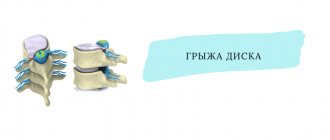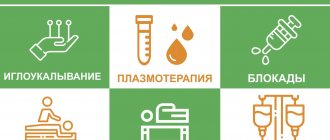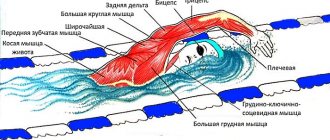Sore throat with cervical osteochondrosis is most often ignored because the general practitioner in the city clinic is in a hurry to make an erroneous diagnosis of acute respiratory infections or tonsillitis. Although in fact the patient has nothing of the kind and the prescribed treatment is unlikely to help him. Yes, a non-steroidal anti-inflammatory drug in the form of acetylsalicylic acid stops inflammation, and an antihistamine will eliminate angioedema. Formally, the patient will really feel an improvement in his condition. But in reality everything is not so simple.
Sore throat with osteochondrosis of the cervical spine is not caused by infection of the mucous membranes, but by a disruption of the process of tissue innervation. As a result, a spasm of small blood vessels is observed, tissue trophism is disrupted, a secondary ischemic reaction and oxygen starvation occurs. All this leads to the fact that the cells of the mucous membrane of the throat begin to collapse and the process of aseptic inflammation starts. It is this that produces the primary pain syndrome.
If treatment is not started at this stage, then a violation of the innervation of deeper layers occurs in the future. The swallowing muscles, vocal cords, etc. gradually begin to be affected. All this leads to hoarseness, difficulty breathing, swallowing, and a constant feeling of a lump in the throat. And all these symptoms can be interpreted as signs of pathology of the larynx, pharynx, and palatine tonsils. The patient is given an incorrect diagnosis of pharyngitis, tonsillitis, laryngitis, tracheitis, etc. And again, incorrect treatment begins to be carried out, which transforms the pathological process into a chronic course.
If you have discomfort in the neck and collar area and at the same time you experience regular signs of trouble in the throat, then do not rush to see a therapist or otolaryngologist. It is likely that these clinical manifestations indicate severe damage to the radicular nerves and their branches. We strongly recommend that you visit a neurologist or vertebrologist. These specialists will be able to make an accurate diagnosis and exclude the possibility of disruption of the innervation of the throat tissue against the background of developing cervical osteochondrosis.
In Moscow, you can make an appointment for a free appointment with a vertebrologist or neurologist right now. In our manual therapy clinic, a free initial appointment with a vertebrologist or neurologist is provided to each patient. During it, a full examination and manual examination is carried out. The doctor makes a preliminary diagnosis and gives individual recommendations for comprehensive treatment and examination.
Make an appointment now: call us or fill out the form at the bottom of this page. Our administrator will contact you and agree on a time convenient for your visit.
Can a sore throat hurt with cervical osteochondrosis?
Many patients wonder whether a sore throat can occur with cervical osteochondrosis and why this rather specific symptom appears. In order to understand the question of whether a sore throat can occur with osteochondrosis of the cervical spine, we suggest first gleaning some information about the physiology and anatomy of the human body. We will consider the cervical spine and laryngeal tissue.
The cervical spine consists of seven vertebral bodies, the first and second of which do not have an intervertebral disc. They are connected to each other using a joint. Responsible for head mobility. The remaining bodies of the cervical vertebrae are separated by cartilaginous intervertebral discs. They are responsible for the uniform distribution of shock-absorbing load and protect the radicular nerves from compression pressure from the adjacent vertebral bodies.
Inside the spine is the spinal cord. This is the most important structural part of the autonomic nervous system. With the help of paired radicular nerves, it provides innervation to all tissues of the human body. In particular, the radicular nerves extending from the cervical spine are responsible for the innervation of the tissues of the larynx, pharynx, and trachea. They ensure the tone of blood vessels, control the process of mucus production, provide primary local immunity, etc.
The radicular nerves leave the spinal cord structure through the lateral foramina in the vertebral bodies. If degenerative dystrophy of the cartilage tissue of the fibrous ring of the intervertebral disc occurs, then it sags and does not provide full protection of the radicular nerve.
Degenerative dystrophic changes in the cartilaginous tissues of the intervertebral disc are osteochondrosis. Protrusion or reduction in the height of the intervertebral disc is the second stage of osteochondrosis. It is with this that a sore throat and other unpleasant symptoms begin to appear, indicating a lack of innervation.
The main reasons why sore throat appears due to the development of cervical osteochondrosis:
- spasm of the neck muscles, leading to disruption of blood supply and compression of other soft tissues;
- disruption of the blood supply to tissues, as a result of which the cells of the mucous membrane of the pharynx and larynx begin to experience oxygen starvation and are subject to ischemia, this provokes inflammation, manifested by hyperemia;
- angioedema of soft tissues;
- decreased local immune defense of the mucous membrane;
- irradiation of radicular pain syndrome from the cervical spine.
All these pathological changes lead to disruption of the physiology of the throat tissue. The process of mucus production in cells, which has a protective effect, is disrupted. The level of blood flow decreases and cell atrophy is provoked. Cicatricial ischemic deformations may also occur, which significantly worsen the condition of all tissues of the throat.
If a sore throat occurs against the background of cervical osteochondrosis, it is necessary to take emergency measures to restore normal tissue innervation. Otherwise, serious complications may develop.
Diagnostics
Any diagnosis begins with collecting complaints and examining the patient. It is not often that people who come to the clinic with a sore throat are sent to a rheumatologist or traumatologist.
Initially, therapists or general practitioners work with this symptom for the purpose of differential diagnosis (infectious diseases such as pharyngitis).
The patient needs to have his blood tested
At the second stage there are laboratory and instrumental methods:
- Laboratory research:
- UAC - leukocytosis and formula shift is insignificant or absent;
- TAM — within normal limits or mild leukocyturia (5–9);
- HD - elevated levels of ASLO, rheumatoid factor and streptokinase.
- Instrumental studies:
- radiography - changes in the spinal column (osteoporosis, deformation of the articular surface);
- bone densitometry - changes in bone density;
- bronchoscopy - in this case it is enough to reach the vocal cords with a bronchoscope (the goal is to determine possible deformation of the trachea);
- FGDS - the goal is to see if there is deformation of the esophagus due to the destruction of bone structures and their protrusion towards the esophagus and trachea.
One of the diagnostic methods, X-ray
MRI/CT, is prescribed only in extremely difficult and doubtful cases and, in particular, when laryngeal cancer is suspected (tumor-like protrusion of unknown origin).
How does a sore throat hurt with cervical osteochondrosis?
It is very difficult to understand on your own whether a sore throat is caused by osteochondrosis of the cervical spine or whether it is the result of a viral or bacterial infection. An examination by an otolaryngologist and a neurologist is necessary. Although most often during the initial examination, the otolaryngologist sees a clinical picture that is classic for laryngitis or pharyngitis. This is swelling of the mucous membranes and hyperemia. Spasm of the laryngeal muscles and narrowing of the glottis can also be observed. And all this can be caused not by infection, but by cervical osteochondrosis.
If you have a sore throat due to osteochondrosis of the cervical spine, there are never symptoms associated with the infection. This is an increase in body temperature, aches in the large muscles of the lower and upper extremities, weakness, dizziness, chills. Also, in most cases there is no runny nose, nasal congestion, rhinorrhea, sneezing, or cough.
There are distinctive signs of a sore throat with cervical osteochondrosis:
- attacks are combined with unpleasant sensations in the neck and collar area;
- the pain can completely go away after a full night's rest (if the sleeping place is organized correctly and there is no tension in the neck muscles during night sleep);
- the pain is felt localized;
- palpation of the neck reveals pain in the spinous processes of the spinal column;
- You can palpate excessively tense muscles of the neck and collar area;
- Almost always, soreness in the throat gives a feeling of difficulty swallowing;
- the submandibular lymph nodes always remain normal and do not become inflamed.
An experienced neurologist, with the help of a manual examination and diagnostic functional tests, will be able to accurately determine whether osteochondrosis is causing a sore throat or something else. Therefore, if such unpleasant sensations appear, first of all, contact a neurologist or vertebrologist. Under no circumstances should you self-treat at home.
Treatment
Treatment of cervical osteochondrosis is always a comprehensive approach. The reason is the damage to several structural components at once:
- joint components (articular cavities, cartilage tissue, osseous tissue);
- nerve plexuses (synoptic ganglia running along the spine);
- regional vessels.
Treatment of cervical osteochondrosis should be comprehensive.
The classic treatment options include the following methods:
- drugs from 2 groups (NSAIDs + chondroprotectors);
- local therapy (gels, ointments);
- physiotherapy (any of the methods, but one);
- Exercise therapy.
All others (surgical method, massage) are used according to indications and not always.
Drug treatment
Drug therapy is the first and main stage of treatment. For mild to moderate forms, 1–2 courses of medications will achieve a noticeable positive effect.
Main areas of treatment:
- pain relief;
- regeneration of affected tissues;
- restoration of motor function and physical activity;
- elimination of local symptoms (hyperemia, edema).
The first stage of treatment is taking medications.
All drugs can be divided according to their effect:
- are common;
- local.
The first group will include:
- NSAIDs are an absolutely typical and irreplaceable group of drugs, since they immediately have anti-inflammatory, antipyretic, and analgesic effects. The course depends on the specific drug (Diclofenac, Ibuprofen).
- Chondroprotectors - protect the joint from further destruction. Two options for use: tablet form or injections (i.m.). An example is Chondroxide.
- Bisphosphonates - prevent the development of bone changes (osteoporosis).
- Muscle relaxants (Calmirex) are used only if there is muscle spasm. In other cases, it is not included in the treatment regimen.
Treatment of a sore throat is a symptomatic treatment option. The reason is that a sore throat is a consequence, and the therapy should be based on the root cause (that is, osteochondrosis). Therefore, we additionally recommend:
- Spray with an anesthetic effect.
- Hormonal drugs (effective against all symptoms of osteochondrosis, but serve only as an addition due to a large number of contraindications).
- When a bacterial or viral infection occurs, broad-spectrum or antiviral antibiotics are used (complications such as pharyngitis).
Various ointments and gels are used locally. In the traditional version, it is NSAIDs.
Rubbing the anterior part of the neck is not recommended due to its absolute ineffectiveness (anatomically, the large vessels and thymus come first, then the trachea, and only then the esophagus). Not a single ointment is able to “reach” the affected area.
Washing the throat with antiseptic solutions or other drugs is not effective, since the cause is not in the throat itself.
Daily gymnastics
At the moment, there are a huge number of different options and integrated approaches to the treatment of osteochondrosis.
Most popular tactics:
- Popov's method;
- Bubnovsky method;
- Evdokimenko's method.
The application of any method will depend on the following points:
- degree of damage;
- level of damage;
- duration and nature of the treatment already performed.
Either method would include:
- tilting the head to the sides;
- tilting the head forward and backward;
- circular movements;
- movements of the upper and lower extremities.
Gymnastics for the neck
Variations of these movements and additions to them are discussed with the patient during consultation. It is better to conduct the first course of therapy with a specialist, and subsequent courses at home at any time.
Self-massage
Massage of the cervical-collar area is used as an addition to the main treatment. The most popular technique is self-massage and there are several reasons for this:
- availability;
- efficiency;
- execution at any convenient time;
- any frequency and intensity of classes;
- does not require additional equipment;
- relatively good efficiency.
Neck massage is an additional tool to the main treatment.
The only nuance in implementation is a rational approach (do not try to cure it in one day). Intense force loads will lead to the destruction of the already deformed spine.
Rules and implementation options:
- Zigzag movements in the collar area.
- Movements to the sides and upwards from the spinal column.
- Circular movements from the spinal column outward.
Performing a neck massage with your own hands
Massage from the outer surface of the neck is not recommended. The reasons are the superficial location of large main vessels and the thyroid gland. With the wrong massage tactics, you can provoke a sharp drop in intracranial pressure (the carotid sinus is located 1 cm to the left of the midpoint of the neck) and the release of the T3 hormone (triiodothyronine) from the thyroid gland.
Physiotherapy
Any methods of physiotherapy have their positive sides:
- local enhancement of microcirculation;
- improvement of metabolic processes;
- targeted impact on the affected area with a certain force (individual correction if necessary);
- rapid pain relief;
- enhancing the effect of drugs from the local group (ointments, gels);
- accessibility and relative cost-effectiveness.
Physiotherapeutic methods have a beneficial effect on the body.
Disadvantages of the procedures:
- low effectiveness in monotherapy (only in combination with tablets and exercise therapy);
- One course is rarely enough - hence the lengthening of treatment time.
Contraindications to physiotherapy (in each individual case, consultation with a specialist):
- oncological diseases;
- cardiovascular pathology;
- pregnancy;
- mental illness.
In some cases, physiotherapy is contraindicated.
There is a huge selection of therapeutic treatment options. Below are the most relevant ones:
- Magnetic therapy is the effect of a magnetic field on any part of the body (including the neck). The duration and strength of the effect are individual. The average course is 14 days. The rest period is 3 weeks.
- Electrotherapy (electrophoresis) is the action of electric current. Has an irritating effect. Course 7 days. The break between courses of treatment is at least 2 weeks.
- Shock wave therapy is a high frequency ultrasonic wave. The least traumatic method of all possible. The course is 14 days and a week break.
- Laser therapy - light exposure (wave intensity, usually in the red spectrum). Irritating effect on fabric. The method can lead to the formation of stage I burns. Course 7 days. Break for a month.
- Vibration method - vibrations of different frequencies lead to polarization of cell membranes. Pronounced regenerating property. Course 7 days. Break 2 weeks.
Soreness and burning sensation in the throat with osteochondrosis of the cervical spine
Cervical osteochondrosis sometimes causes a burning sensation in the throat - this is due to a violation of the innervation of small nerve endings located in the thickness of the mucous membrane. Against the background of a burning sensation in the throat with osteochondrosis of the cervical spine, angioedema develops. This is the infiltration of soft tissues with excess fluid against the background of impaired microcirculation of blood and lymphatic fluid due to weakening of the muscular wall of blood vessels.
A sore throat with cervical osteochondrosis can be associated with a number of pathological changes:
- dryness of the mucous membranes when the tone of the vascular bed is disturbed against the background of a disturbance in the innervation process;
- spasm of the laryngeal muscles in acute radicular syndrome, accompanied by difficulty in the process of full inhalation, wheezing may appear;
- atrophy of mucosal cells against the background of long-term disruption of their innervation and trophism. Also, cervical osteochondrosis and sore throat can be related to each other through the so-called “mediation of a third organ.” The fact is that the radicular nerves, which extend in the cervical spine from the structures of the spinal cord, are responsible for the functions of the thyroid gland. With a long course of cervical osteochondrosis, the function of the thyroid gland is impaired. Hyperplasia of its glandular tissue begins. With massive hypertrophy, the thyroid gland begins to put pressure on the trachea and larynx. This results in sore throat, sore throat, tightness and difficulty breathing.
When such clinical symptoms appear, it is necessary to begin effective treatment of cervical osteochondrosis as quickly as possible in order to completely restore the damaged tissue innervation. If this is not done, then there is a high probability of atrophic processes in the tissues of the throat, larynx, trachea, and thyroid gland.
Description of the pathology
Osteochondrosis is a degenerative-dystrophic disease of the joints, leading to the destruction of its components and dysfunction.
The pathogenesis of this pathology lies in the slow, systematic destruction of osteochondral structures. As it progresses, the intervertebral joints lose their functional activity. The cartilage tissue and the articular cavity itself begin to be replaced by connective tissue. The joint cavity becomes larger and compresses the roots of the paravertebral nerve plexuses. This is where a typical symptom of osteochondrosis arises - pain.
What does the spine look like with osteochondrosis?
When there is a lesion in the cervical spine, the vertebral artery is also compressed (vertebral artery syndrome). This cause of oxygen starvation of the brain leads to damage to the visual and auditory centers and impaired sensitivity of the limbs.











